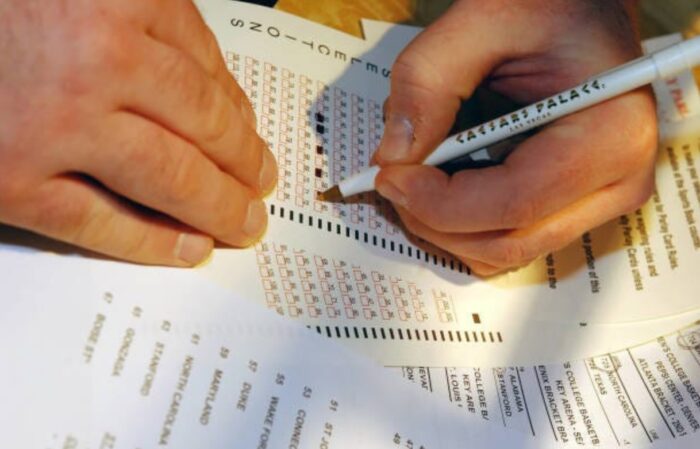
Sports betting has been around for centuries, and as a result, it has developed into a complex industry with intricate systems and strategies. Understanding the math behind the odds is essential to being a successful bettor, as it allows you to make informed decisions and maximize your chances of winning.
In recent sports news, we have seen a rise in the popularity of sports betting. With the legalization of betting in many states in the United States, more and more people are becoming interested in trying their hand at wagering on sports. However, if you want to make money betting on sports, you need to understand the math behind the odds.

Types of Odds Formats: Decimal, Fractional, and American
The first thing you need to understand about probability is the different formats they come in. The three most common formats are decimal, fractional, and American odds.
Decimal odds are the most straightforward format to understand. They represent the total payout for a winning bet, including the original stake. For example, if you bet $10 on a team with odds of 2.5, you would receive a total payout of $25 if that team wins.
Fractional odds are a bit more complicated. They represent the ratio of the amount won to the amount staked. For example, if you bet $10 on a team with odds of 5/1, you would receive a total payout of $60 ($50 in winnings plus your original $10 stake).
American odds are the most commonly used odds format in the United States. They represent the amount you would need to bet to win $100 (when the odds are negative) or the amount you would win if you bet $100 (when the odds are positive). For example, if a team has odds of -150, you would need to bet $150 to win $100. If a team has odds of +200, you would win $200 if you bet $100.
Understanding Implied Probability and Expected Value
Once you understand the different odds formats, you need to know how to use them to calculate implied probability and expected value.
Implied probability is the probability of an event occurring as reflected by the odds. For example, if a team has an odds of 2.5, the implied probability of that team winning is 40% (1/2.5).
Expected value is the amount you can expect to win or lose on a bet over the long term. It takes into account the probability of winning or losing and the payout for each outcome. To calculate the expected value, you simply multiply the probability of winning by the payout and subtract the probability of losing multiplied by the amount staked. A positive expected value indicates a bet that is likely to be profitable over the long term.

Factors Affecting Odds: Injuries, Weather, Public Opinion, etc.
As a bettor, it is essential to understand the factors that can affect odds. Injuries to key players, weather conditions, and public opinion can all have a significant impact on the odds. For example, if a star player is injured, the chances of their team winning will likely decrease, making it a more attractive bet for the other team.
There are other factors that can affect betting odds. For example, the location of the game, the playing surface, and the time of day can all play a role in determining the odds. By understanding the various factors that can impact the probabilty, bettors can make more informed decisions and potentially identify opportunities to find value bets. However, it’s important to remember that bookmakers also take these factors into account when setting the odds, so it’s not always easy to find an edge.
Analyzing Betting Trends and Statistics
Analyzing betting trends and statistics is a key strategy used by successful sports bettors. By examining past performance, bettors can identify patterns and trends that can help them make more informed betting decisions. For example, they may look at a team’s performance against certain opponents, or examine how a team performs under certain weather conditions.
They may also look at individual player statistics, such as how often a certain player scores or how frequently they get injured. By analyzing this data, bettors can gain insights into a team’s strengths and weaknesses and make more informed bets. However, it’s important to use a variety of sources and not rely solely on statistics, as there are many factors that can influence the outcome of a game.

Using Mathematical Models to Gain an Edge in Sports Betting
Mathematical models are another tool that can give you an edge in betting. There are various models that use statistics and other data to predict the outcome of a game, such as regression models, machine learning algorithms, and more. However, it’s important to remember that no model is 100% accurate, and you should always use them in conjunction with other strategies.
Bankroll Management Strategies for Sports Bettors
Bankroll management is a crucial aspect of sports betting. It refers to how you manage the money you have set aside for betting. A good bankroll management strategy can help you minimize your losses and maximize your profits. One common strategy is the Kelly criterion, which involves betting a percentage of your bankroll based on the odds and your perceived edge.
The Role of Luck
While understanding the math behind sports betting can improve your chances of success, it’s important to remember that luck still plays a significant role in sports betting. Upsets can happen, and even the most well-informed bettors can still lose bets. It’s crucial to approach sports betting with a long-term perspective and not get discouraged by short-term losses. By practicing good bankroll management, making informed decisions based on data and analysis, and embracing the role of luck in sports betting, you can improve your chances of long-term success.

Conclusion: Applying Math to Improve Your Sports Betting Success
Sports betting odds are a complex yet powerful tool in the world of gambling. With the right knowledge and understanding, you can make informed decisions when it comes to placing your bets. By better understanding how they work, you can gain an advantage over other bettors who lack this insight. From fractional to decimal chances, sportsbooks have multiple ways of displaying their lines for bettors to interpret; having an awareness of each type will help you develop into a more successful gambler in the long run.











